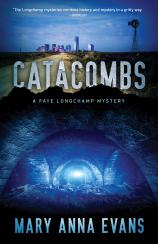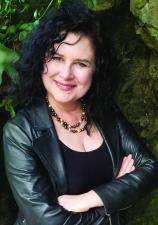Author Talk: August 15, 2019
Mary Anna Evans is the author of the Faye Longchamp archaeological mysteries, which have received such recognition as the Benjamin Franklin Award, the Mississippi Author Award, and three Florida Book Awards bronze medals. The 12th and latest installment in the series, CATACOMBS, revolves around an explosion at a historic Oklahoma City hotel that leads to the discovery of the bodies of three children buried deep beneath the city. In this interview, Evans talks about the importance of the story’s Oklahoma setting, the Faye book that elicited the most responses from readers, the two mystery/thriller authors she admires the most, and the research she conducted on Oklahoma’s history (which was so thorough that it even caught the attention of law enforcement!).
Question: Since the publication of ARTIFACTS, the first novel in your series about Faye Longchamp --- an archaeologist who is also a sleuth --- your work has drawn the attention of mystery fans who enjoy a historical theme to go with murder most foul. Has there been one Faye book in particular that elicited the most responses from your readers?
Mary Anna Evans: I frequently get emails from people who want to know if a particular person or place that I've included in a historical backstory is real. If I had to say which book got the most questions about the backstory, I'd have to say it was STRANGERS. In particular, people want to know if Father Domingo Sanz de la Fuente really lived. The answer is no. There really was a priest who crossed the Atlantic with the group who founded Saint Augustine, and I read translated excerpts from his journal as part of my research. Then I created Father Domingo and put him by the side of the real priest because I don't like to muck about with the lives of real people. I'm very attached to Father Domingo. I wish he were real, too. I'm pretty sure that people who read CATACOMBS will wish that Cully Mantooth was an actual movie star.
Q:No less a figure than Tony Hillerman expressed admiration for your early novels. Do you feel the Faye series to some extent is now carrying that same flame --- crime set against an anthropological background --- that distinguished Hillerman's lauded body of work?
MAE: I do. At least I try to carry that flame. I admire the ancient cultures of the Americas very much, and I am always happy when a story gives me a chance to highlight their achievements and the things they have to teach the rest of us. In CATACOMBS, I continue with that theme by centering the book on a conference celebrating indigenous art that brings together people indigenous to the Americas with immigrants and descendants of immigrants from Asia, Africa and Europe. Humanity has created so many things worth celebrating.
Q: Looking at the current landscape in mystery fiction, is there an author whose work you particularly admire, even if it has little to do with your own series? And which author from the past has most influenced you as a writer?
MAE: I love the work of James Lee Burke --- the lyrical language, the warmth of his portrayal of his characters, and the palpable reality of his settings.
It might be a cliché, but I would be a liar if I said I wasn't inspired by the work of Agatha Christie. I'm always amazed when I think about how many ingenious plots she crafted, not just in her 66 novels, but in dozens of short stories and plays, as well. Without revealing spoilers, I can say that her rule-breaking approach to the conventions of the crime fiction genre in novels like THE MURDER OF ROGER ACKROYD, MURDER ON THE ORIENT EXPRESS and AND THEN THERE WERE NONE was revolutionary. And she wrote these classics of crime fiction at a time when women had just begun to participate in their society and their justice system by voting, sitting on juries, and serving as attorneys and judges. I find this extraordinary.
Q: Could you discuss the importance of the Oklahoma setting of CATACOMBS?
MAE: In short, the story could take place nowhere else. In researching Oklahoma City, I learned that there is documented evidence that a community of perhaps 200 people lived underneath the city's downtown area. They were Chinese immigrants who, because of low pay and racial prejudice, had difficulty renting apartments and thus often lived in undesirable basement lodgings. They enlarged these small, dark apartments by digging out into the soil, and eventually these chambers merged into underground corridors. We have a health department report from the 1920s and photographs from the 1960s to confirm the oral histories, although the chambers, corridors and staircases are no longer accessible. When I read about this, I thought, "Wouldn't my archaeologist protagonist, Faye Longchamp-Mantooth, love to get a look at those old catacombs?" And then I made it so.
Q: How did you research the Oklahoma history that fuels the plot of this new book?
MAE: A number of old newspaper articles exist that describe the underground Chinese community, and oral histories have been collected and presented in blogs over the years. Because an element of the plot involves old storm sewers in the vicinity of the old chambers, I paid a visit to civil engineers who work for the city of Oklahoma City to find out what the real sewers look like. I may have scared them a little, because I got a phone call from a very nice policeman who just wanted to make sure I wasn't planning to draw a road map with instructions on how to set off a bomb under the city. I told him that I had no intentions of doing that, and all was well. This is the first time in 17 years of writing crime fiction that I've caught the attention of law enforcement, so I feel oddly proud.
Q: Has Faye developed as a character in any ways that you did not anticipate when you wrote the first book in the series all those years ago?
MAE: Faye has always been smart and ambitious, but she's also loving and tenderhearted. Those things come together for her in CATACOMBS, when she sees that people appreciate and value Joe's skills as an expert flintknapper. Her ambition is channeled toward helping him be successful apart from her, and she does her best to take a backseat and let him shine. The FBI doesn't let her stay in the backseat, of course, because she is the one who has the expertise to help them find out who masterminded the bombing that opens CATACOMBS, but she is happy for Joe to have a chance to shine. I think readers will be, too.




